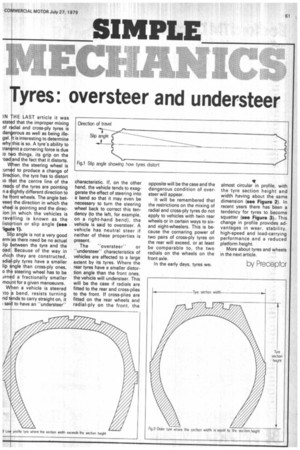yres: oversteer and understeer
Page 63

If you've noticed an error in this article please click here to report it so we can fix it.
IN HE LAST article it was stat d that the improper mixing of r dial and cross-ply tyres is dan erous as well as being illegal. t is interesting to determine why this is so. A tyre's ability to tran mit a cornering force is due
o t o things, its grip on the -oad and the fact that it distorts.
hen the steering wheel is .urn d to produce a change of Jire tion, the tyre has to distort :o t at the centre line of the rea s of the tyres are pointing n a lightly different direction to he f ont wheels. The angle betvee the direction in which the vhe I is pointing and the direcion in which the vehicles is rav Iling is known as the list rtion or slip angle (see igu e 1)..
SI p angle is not a very good erm as there need be no actual lip ietween the tyre and the oad Because of the way in vhic they are constructed, 3dia -ply tyres have a smaller lip ngle than cross-ply ones, o th steering wheel has to be Jrn d a fractionally smaller mo nt for a given manoeuvre.
W en a vehicle is steered -Ito a bend, resists turning nd t nds to carry straight on, it
sai i to have an "understeer" characteristic. If, on the other hand, the vehicle tends to exaggerate the effect of steering into a bend so that it may even be necessary to turn the steering wheel back to correct this tendency (to the left, for example, on a right-hand bend), the vehicle is said to oversteer. A vehicle has neutral steer if neither of these properties is present.
The ''oversteer'' or "understeer" characteristics of vehicles are affected to a large extent by its tyres. Where the rear tyres have a smaller distortion angle than the front ones, the vehicle will understeer. This will be the case if radials are fitted to the rear and cross-plies to the front. If cross-plies are fitted on the rear wheels and radial-ply on the front, the
opposite will be the case and the dangerous condition of oversteer will appear.
It will be remembered that the restrictions on the mixing of radial and cross-ply tyres do not apply to vehicles with twin rear wheels or in certain ways to sixand eight-wheelers. This is because the cornering power of two pairs of cross-ply tyres on the rear will exceed, or at least be comparable to, the two radials on the wheels on the front axle.
In the early days, tyres we:
almost circular in profile, with the tyre section height and width having about the same dimension (see Figure 2). In recent years there has been a tendency for tyres to become squatter (see Figure 3). This change in profile provides advantages in wear, stability, high-speed and load-carrying performance and a reduced platform height.
More about tyres and wheels in the next article.
by Preceptor








































































































